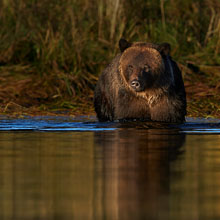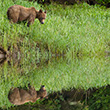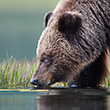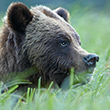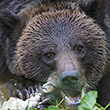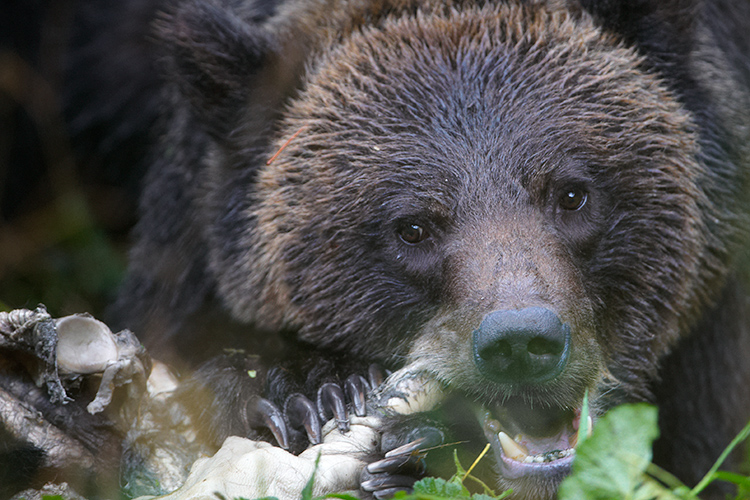
In the Field
Bad Day to be a Black Bear. Great Bear Rainforest (northern BC coast). October 7, 2008.
This brown (or grizzly) bear was having a very good day when I shot this image, but the owner of the leg-bone being chewed on - an anonymous black bear - wasn't fairing quite as well! It's well known that grizzlies and black bears don't always get along well, but instances of one species (usually grizzlies) actually killing and consuming the other species (usually black bears) aren't commonly stumbled upon. Yet during a 9-day trip into the Great Bear Rainforest in October 2008 we came across two instances of grizzlies preying upon black bears. The grizzlies in the inlet that we were "camped out" in were acting atypically during this trip - they were also spending a huge amount of their time digging for bulbs and roots (normally their primary activity in October is fishing for and consuming huge numbers of nutrient-rich salmon). But the inlet we were in had - for the first time in living memory - virtually no salmon run in the fall of 2008. There are many possible explanations for this (warming ocean currents, over-fishing, a combination thereof, etc.), but most include a large element of human intervention in natural processes. Whether or not the salmon will return in 2009 is unknown, as is the long-term effect on the ecosystem of the Great Bear Rainforest, which has been shaped by, and is dependent upon, the large nutrient "injection" provided by spawning salmon. The situation depicted in this image may become more common in the future...
About this documentary image: I shot this image from an inflatable zodiac boat that was floating just off the shoreline and the grizzly bear (and 3 others) were only a few meters away (this image has only about 10% of the original cropped off). I was using a long telephoto lens (600 mm) and had no choice but to hand-hold the camera and lens combo. The scene was pretty much "on the edge" of what can be captured using current technology - the lens was wide open, I shot the image at ISO 1600 (which would have been a ludicrous ISO setting one short year ago), and I had to rely on the lens's Vibration Reduction (VR) system to let me get away with hand-holding the monster lens at only 1/60s. Shots like this make me appreciate the rapid (and sometimes frustrating) rate of product development (and obsolescence) in the photography industry.
Behind the Camera
Bad Day to be a Black Bear. Great Bear Rainforest (northern BC coast). October 7, 2008.
Digital Capture; Compressed RAW (NEF) 14-bit format; ISO 1600.
Nikon D700 with AF-S Nikkor 600mm f/4G IF-ED II VR lens - handheld in floating Zodiac inflatable boat. VR turned to "On" and in "Normal" mode. Autofocus set to M/a mode.
1/60s @ f4; -0.3 stop compensation from matrix-metered exposure setting.
At the Computer
Bad Day to be a Black Bear. Great Bear Rainforest (northern BC coast). October 7, 2008.
RAW Conversion to 16-bit TIFF, including first-pass/capture sharpening, white balance adjustment and slight exposure adjustment using Phase One's Capture One Pro 4.5.
Further digital corrections on 16-bit TIFF file using Adobe's Photoshop CS3. Adjustments included selective colour satuation (and desaturation) and selective sharpening for web output.
Conservation
Bad Day to be a Black Bear. Great Bear Rainforest (northern BC coast). October 7, 2008.
Ten percent of the revenue generated by this image will be donated to Raincoast*.
Species Status in Canada**: Special Concern (May 2002).
While Grizzly Bears (Ursus arctos) are not technically listed as "Endangered" in Canada, they have been extirpated from most of their historical range. Grizzly Bears are far more sensitive to intrusion/disturbance in their habitat than are Black Bears and are being increasingly forced into marginal habitat by human encroachment. The Great Bear Rainforest along the central and northern coast of British Columbia is one of the last strongholds of the Grizzly Bear in Canada, and even this population is coming under increasing pressure.
On December 18, 2017 the government of British Columbia banned grizzly hunting across the entire province. This major conservation victory came after decades of tireless work by many dedicated conservationists and ecologists and, most importantly, it reflects the opinion of the vast majority of British Columbians. And, it means that AT LEAST while the current government remains in power grizzlies are finally "safe" in British Columbia.
Now that we've at least temporarily won the battle to save grizzlies in BC, it's time to re-focus our efforts toward protecting ALL of BC's carnivores, including Gray Wolves, Black Bears, Cougars, Wolverines, and more! Simply put, there are no ecological, economic, or ethical arguments supporting the trophy hunting of carnivores.
In a great first step towards ending the hunting of carnivores throughout BC the Raincoast Conservation Foundation has developed a program designed to protect ALL carnivores within the Great Bear Rainforest. Details about this program can be found on this page on Raincoast's website. Check it out and, better yet, make a donation to help Raincoast purchase the remaining commercial hunting tenures in the Great Bear!
*The Raincoast Conservation Society (and Foundation) is an effective and efficient organization that has been fighting for protection of this unique habitat. If you are looking for a meaningful way to contribute to the conservation of this amazing ecosystem, Raincoast will provide maximal "bang" for your conservation dollars.
**as determined by COSEWIC: The Committee on the Status of Endangered Wildlife in Canada


















